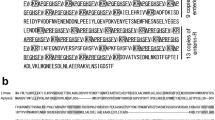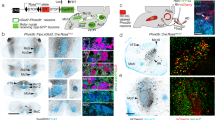Abstract
In the pond snail Lymnaea stagnalis octopamine-containing (OC) interneurons trigger and reconfigure the feeding pattern in isolated CNS by excitation of the central pattern generator. In semi-intact (lip–mouth—CNS) preparations, this central pattern generator is activated by chemosensory inputs. We now test if sucrose application to the lips activates the OC neurons independently of the rest of the feeding central pattern generator, or if the OC interneuron is activated by inputs from the feeding network. In 66% of experiments, sucrose stimulated feeding rhythms and OC interneurons received regular synaptic inputs. Only rarely (14%) did the OC interneuron fire action potentials, proving that firing of OC interneurons is not necessary for the sucrose-induced feeding. Prestimulation of OC neurons increased the intensity and duration of the feeding rhythm evoked by subsequent sucrose presentations. One micromolar octopamine in the CNS bath mimicked the effect of OC interneuron stimulation, enhancing the feeding response when sucrose is applied to the lips. We conclude that the modulatory OC neurons are not independently excited by chemosensory inputs to the lips, but rather from the buccal central pattern generator network. However, when OC neurons fire, they release modulatory octopamine, which provides a positive feedback to the network to enhance the sucrose-activated central pattern generator rhythm.








Similar content being viewed by others
References
Alania M, Sakharov DA, Elliott CJH (2004) Multilevel inhibition of feeding by a peptidergic pleural interneuron in the mollusc Lymnaea stagnalis. J Comp Physiol A 190:379–390
Arshavsky YI, Deliagina TG, Orlovsky GN, Panchin YV, Popova LB, Sadreyev RI (1998) Analysis of the central pattern generator for swimming in the mollusk Clione. Ann New York Acad Sci 860:51–69
Benjamin PR, Elliott CJH (1989) Snail feeding oscillator: the central pattern generator and its control by modulatory interneurons. In: Jacklet JW (ed) Neuronal and cellular oscillators. Marcel Dekker, New York
Elliott CJH, Benjamin PR (1985) Interactions of the slow oscillator interneuron with feeding pattern-generating interneurons in Lymnaea stagnalis. J Neurophysiol 54:1412–1421
Elliott CJH, Susswein AJ (2002) Comparative neuroethology of feeding control in molluscs. J Exp Biol 205:877–896
Elliott CJH, Vehovszky A (2000) Polycyclic neuromodulation of the feeding rhythm of the pond snail Lymnaea stagnalis by the intrinsic octopaminergic interneuron, OC. Brain Res 887:63–69
Hernadi L, Hiripi L, Dyakonova V, Gyori J, Vehovszky A (2004) The effect of food intake on the central monoaminergic system in the snail, Lymnaea stagnalis. Acta Biol Hung 55:185–194
Katz PS, Frost WN (1995) Intrinsic neuromodulation in the Tritonia swim CPG—serotonin mediates both neuromodulation and neurotransmission by the dorsal swim interneurons. J Neurophysiol 74:2281–2294
Kemenes G, Elliott CJH, Benjamin PR (1986) Chemical and tactile inputs to the Lymnaea feeding system—effects on behavior and neural circuitry. J Exp Biol 122:113–137
Kemenes G, Staras K, Benjamin PR (2001) Multiple types of control by identified interneurons in a sensory-activated rhythmic motor pattern. J Neurosci 21:2903–2911
Kupfermann I, Teyke T, Rosen SC, Weiss KR (1991) Studies of behavioral state in Aplysia. Biol Bull 180:262–268
McCrohan CR, Benjamin PR (1980a) Patterns of activity and axonal projections of the cerebral giant cells of the snail Lymnaea stagnalis. J Exp Biol 85:149–168
McCrohan CR, Benjamin PR (1980b) Synaptic relationships of the cerebral giant cells with motoneurones in the feeding system of Lymnaea stagnalis. J Exp Biol 85:169–186
Rose RM, Benjamin PR (1981a) Interneuronal control of feeding in the pond snail Lymnaea stagnalis. 1. Initiation of feeding cycles by a single buccal interneurone. J Exp Biol 92:187–201
Rose RM, Benjamin PR (1981b) Interneuronal control of feeding in the pond snail Lymnaea stagnalis. 2. The interneuronal mechanism generating feeding cycles. J Exp Biol 92:203–228
Satterlie RA (1985) Reciprocal inhibition and postinhibitory rebound produce reverberation in a locomotor pattern generator. Science 229:402–404
Staras K, Kemenes G, Benjamin PR (1999a) Cellular traces of behavioral classical conditioning can be recorded at several specific sites in a simple nervous system. J Neurosci 19:347–357
Staras K, Kemenes G, Benjamin PR (1999b) Electrophysiological and behavioral analysis of lip touch as a component of the food stimulus in the snail Lymnaea. J Neurophysiol 81:1261–1273
Thomas JD, Lough AA, Lodge RW (1975) The chemical ecology of Biomphalaria glabrata (Say) the snail host of Schistosoma mansoni Sambon: the search for factors in media conditioned by snail which inhibit their growth and reproduction. J Appl Ecol 12:421–434
Tuersley MD, McCrohan CR (1989) Post synaptic actions of serotonergic cerebral giant-cells on buccal motoneurones in the snail Lymnaea stagnalis. Comp Biochem Physiol C 92:377–383
Vehovszky A, Elliott CJH (2000) The octopamine-containing buccal neurons are a new group of feeding interneurons in the pond snail Lymnaea stagnalis. Acta Biol Hung 51:165–176
Vehovszky A, Elliott CJH (2001) Activation and reconfiguration of fictive feeding by the octopamine-containing modulatory OC interneurons in the snail Lymnaea. J Neurophysiol 86:792–808
Vehovszky A, Elliott CJH (2002) Heterosynaptic modulation by the octopaminergic OC interneurons increases the synaptic outputs of protraction phase interneurons (SO, N1L) in the feeding system of Lymnaea stagnalis. Neuroscience 115:483–494
Vehovszky A, Elliott CJH, Voronezhskaya EE, Hiripi L, Elekes K (1998) Octopamine: A new feeding modulator in Lymnaea. Phil Trans Roy Soc Lond B 353:1631–1643
Vehovszky A, Hiripi L, Elliott CJH (2000) Octopamine is the synaptic transmitter between identified neurons in the buccal feeding network of the pond snail Lymnaea stagnalis. Brain Res 867:188–199
Vehovszky A, Szucs A, Szabo H, Pitt S, Elliott CJH (2004) Octopaminergic modulation of the membrane currents in the central feeding system of the pond snail Lymnaea stagnalis. Acta Biol Hung 55:167–176
Yeoman MS, Vehovszky A, Kemenes G, Elliott CJH, Benjamin PR (1995) Novel interneuron having hybrid modulatory-central pattern generator properties in the feeding system of the snail, Lymnaea stagnalis. J Neurophysiol 73:112–124
Yeoman MS, Brierley MJ, Benjamin PR (1996) Central pattern generator interneurons are targets for the modulatory serotonergic cerebral giant-cells in the feeding system of Lymnaea. J Neurophysiol 75:11–25
Acknowledgements
We are grateful to The Welcome Trust for their support. The experiments comply with the Principles of animal care, publication No. 86-23, revised 1985 of the National Institutes of Health, and also with the current laws of the UK and Hungary.
Author information
Authors and Affiliations
Corresponding author
Rights and permissions
About this article
Cite this article
Vehovszky, Á., Szabó, H. & Elliott, C.J.H. Octopamine-containing (OC) interneurons enhance central pattern generator activity in sucrose-induced feeding in the snail Lymnaea. J Comp Physiol A 190, 837–846 (2004). https://doi.org/10.1007/s00359-004-0539-y
Received:
Revised:
Accepted:
Published:
Issue Date:
DOI: https://doi.org/10.1007/s00359-004-0539-y




